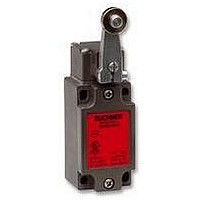NZ1HS-2131-M EUCHNER, NZ1HS-2131-M Datasheet - Page 5

NZ1HS-2131-M
Manufacturer Part Number
NZ1HS-2131-M
Description
SAFETY SWITCH
Manufacturer
EUCHNER
Datasheet
1.NZ1HS-2131-M.pdf
(127 pages)
Specifications of NZ1HS-2131-M
Actuation Type
Lever
Operating Force Max
15N
Contact Voltage Ac Max
230V
Contact Voltage Dc Max
24V
Contact Current Ac Max
4A
Contact Current Dc Max
4A
Switch Terminals
Screw
Actuator Type
Lever Arm
Actuator Style
Lever
General
Standards and approvals
Standards
Safety switches must meet the requirements for safety components as
per the Machinery directive. The Machinery directive has been imple-
mented in national law in the EU member states and, as a result, is
binding for all manufacturers.
Detailed requirements for the switches are defined in EN 60947 Part 5-1
(Specification for low-voltage switchgear and controlgear. Part 5-1: Control
circuit devices and switching elements. Electromechanical control circuit
devices).
If the requirements of this standard are met, conformity with the applicable
laws and therefore with the Machinery directive is assumed. EUCHNER
safety switches comply with the relevant standards for safety switchgear
and therefore help you to comply with safety requirements during the
design of your machinery.
Approvals
To demonstrate conformity, the Machinery directive also includes the
possibility of type examination. Although all relevant standards are taken
into account during development, we have all our safety switches
subjected to additional type examinations by a notified body.
Many of the safety switches listed in this catalog have been tested by an
employers' liability insurance association and are given in the lists from
the BG.
Furthermore, numerous switches are listed by Underwriters Laboratories
(UL). These switches can be used in countries in which this listing is
required. The approval symbols on the individual pages of the catalog
indicate which body tested the switches.
With the aid of the approval symbols listed below you can quickly see
which approvals are available for the related switches:
Switches with this symbol are approved by
an employers' liability insurance association
Switches with this symbol are approved by
Underwriters Laboratories (UL, Canada and
USA)
Safety switches
The task of safety switches
Safety switches have the task of preventing the operation of a machine
in the case of a potential hazard. This task is defined in EN 1088 (Safety
of machinery. Interlocking devices associated with guards. Principles
for design and selection). For this purpose the safety circuit must be
opened by the safety switch. Safety switches are therefore key elements
of an interlocking device.
In this context an interlocking device is, for example, the interruption of
machine operation if the safety door is open – the stop state of the
machine is ”interlocked” so to speak and unintentional starting is therefore
prevented. In relation to movable safety guards this means that if safety
doors or safety flaps are open, the machine or system cannot be operated
if the machine or system can produce a hazard. For this reason the
safety switch for a safety guard must be attached such that a malfunction
is excluded. Safety switches must also not be tampered with or bypassed.
The most important feature of a safety switch is at least one normally
closed contact which is operated positively. The switching contacts are
separated by a positively driven mechanism when the safety guard is
opened.
Safety switch types
In general, a differentiation is made between safety switches with safety
function and safety switches with separate actuator.
EUCHNER has safety switches with safety function and safety switches
with separate actuator in its range.
Safety switches with safety function
Safety switches with safety function are safety switches in which the
actuating element and the switch are fitted in one housing. The actuating
elements are available in various versions (e.g. in the form of a plunger
or a lever arm). The switches N1A, NB01 and NZ listed in this catalog
are safety switches with safety function.
To actuate a switch with safety function, trip dogs or cams are often
used.
The switch must be attached such that the switch is actuated if the
safety guard is opened. The positively driven contact in the switching
element is then opened and the machine is shut down. A built-in spring
returns the switch to the free position when the safety guard is closed
and the positively driven contact is closed. In this way the safety circuit
is enabled again.
A trip dog with a defined slope should be used to approach the switch.
EUCHNER has various trip dogs in its range.
With safety function
With separate actuator
5

























